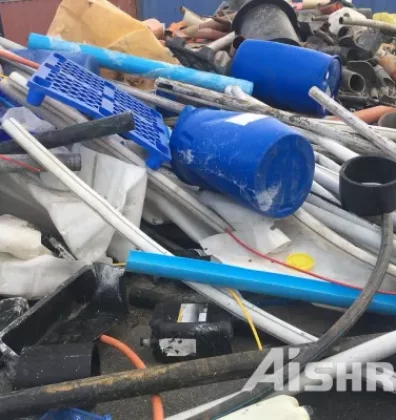Industrial shredders effectively shred solid wood waste, tree trunks, railway sleepers, various construction waste, tires, solid household waste, old furniture, refrigerator cases, pallets with nails, woodworking waste, wood sheet waste, waste paper, glass waste, plastic waste, volumetric plastic containers, plastic pipes, PET bottles, film, almost any kind of existing solid waste.
According to their design, shredders are divided into:
- Single-shaft shredder
- Two-shaft shredder
- Four-shaft shredder
Single-shaft Shredder
A single-shaft shredder is a low-speed shredder with a hydraulic press plate (prepressor) for crushing thick waste and high resistance to shredding: corrugated cardboard, wood waste, wooden boxes and pallets, various types of plastics, bulk polymer containers, plastic pipes, sprues , MSW, car tires.
Single-shaft shredder operation principle
The material to be shredded is fed into the shredder's hopper. Loading of material can be carried out manually or mechanically, using an inclined conveyor or loader. The hydraulic press plate (prepresser) reciprocatingly presses the incoming material against the rotating rotor, with knives mounted on it, which carry out the grinding. The pressure force of the hydraulic press plate is adjusted automatically. At the limit pressure on the cutting shaft of the shredder, the press plate automatically stops the material supply and returns to its original position.
The shredding process continues until the particles of the crushed material can pass through the holes of the fractional sieve installed under the shredder shaft.
The size of the fraction of the final material depends on the diameter of the mesh of the fractional sieve (15-150 mm.). The rotors of single-shaft shredders are made smooth and profiled, coated with wear-resistant alloys.
When grinding hard, abrasive or easily heated materials, the profiled rotor more evenly distributes the heat generated from friction over the entire area of the rotor, which eliminates its overheating or sticking of raw materials and winding on the rotor.
The cutting blades of the shredder are attached to the rotor with bolted connections.
Two-shaft shredder
The two-shaft shredder, thanks to its high torque, allows you to shred almost any waste.
Two-shaft shredder operation principle
When loading waste into the loading hopper , they are captured by knives in the form of hooks and cutting discs mounted on two shafts moving towards each other and crushed to the required fraction. And the side pads clean the knives, discs and ensure that the material flows down.
Four-shaft shredder
Four-shaft shredders are capable of shredding any type of waste: municipal solid waste (MSW), bulky waste, polymer waste of different hardness and thickness, paper, cardboard, wood, leather and textile waste, car tires, rubber waste, asphalt.
Four-shaft shredder operation principle
In a four-shaft shredder, there are two main shafts and two auxiliary shafts. Auxiliary shafts are equipped with special sharp-angled cutting discs and hook-shaped knives. The knives of the auxiliary shafts begin to shred the waste and, thanks to their hook-like shape, catch the shredded material and drag it to the knives of the main shafts, which complete the shredding. The grinding of the material continues until the crushed waste particles reach such a fraction that they can freely pass into the cells of the installed sieve.




